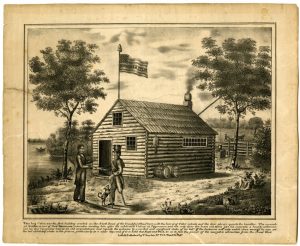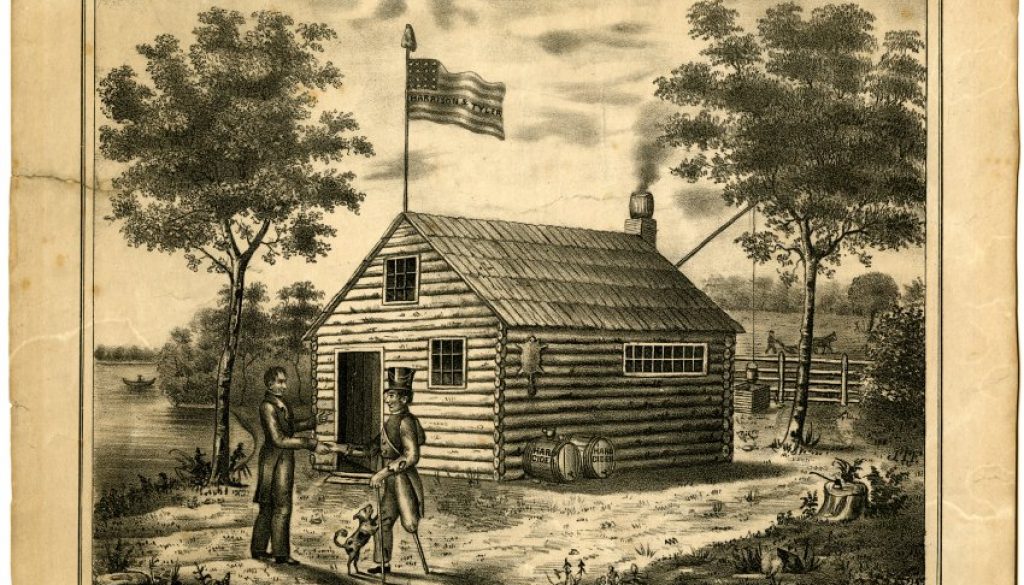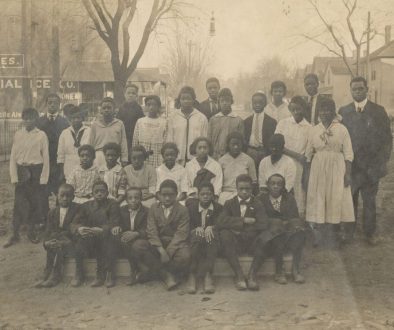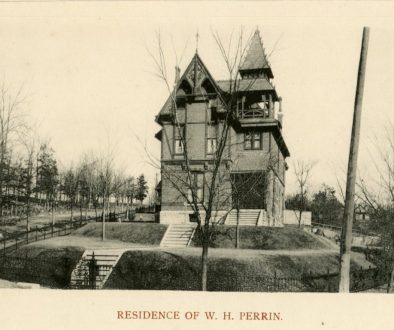“Tippecanoe and Tyler, Too!”
The Great Whig Rally of 1840
Part I
By Julie Dichtl
Editors Note: This article first appeared in the Tippecanoe County Historical Association’s newsletter, Weatenotes, Vol. 24, February 1991. The author served TCHA as Volunteer Coordinator and Weatenotes editor before joining St. Elizabeth Hospital as Director f Volunteer Services in June, 1988.
Under Andrew Jackson’s Democratic rule of the 1830’s, the country fell further and further into a depressed economic state. Many Midwestern states went bankrupt. Paper money was viewed as all but worthless. In 1836, Jackson handpicked as his successor, his vice-president, Martin Van Buren. Shortly after Van Buren took office, it became apparent to the voters of this country that the president would do little to turn around the national economic situation. From out of this mess was born the Whig Party.
The Whig Party was created by a group of politicians whose common goal was to defeat the Democrats. During the twenty years that the party existed, it nominated for president three former generals – William Henry Harrison, Zachary Taylor and Winfield Scott – because “they stood for nothing controversial, antagonized no one, and could be sold to voters … wrapped in an aura of military glory.” 1

The first national Whig convention was held in Harrisburg, Pennsylvania, in 1839. Henry Clay had hoped to be the party’s choice for presidential candidate; however, William Henry Harrison, who had run against Van Buren in 1836, was chosen instead. George Washington himself had commissioned Harrison as an army officer, who then had served under Anthony Wayne at the Battle of Fallen Timbers and was later placed in command at Fort Washington – now Cincinnati. Harrison subsequently had become the Secretary of the Northwest Territory and then, in 1800, Governor. As Major General in the Army, he had directed the capture of Detroit during the War of 1812 and had overseen the Battle of the Thames during which Tecumseh was killed.
Early on in the 1840 campaign, a Baltimore newspaper columnist noted that Harrison would happily retire to his farm if he had a pension, a log cabin and a barrel of hard cider. The Whigs used this derogatory remark to their advantage, installing barrels and real log cabins in every village square that hosted a campaign rally.
Of course, the grandest of all the 1840 campaign rallies was the one held May 29, 1840, on the site of the Battle of Tippecanoe. An estimated 30,000 people attended the rally.
Elijah Edwards later recorded his impressions of the rally: “We spent the winter of 1839 and ’40 in the orchard cabin. During the last named year we witnessed a magnificent political pageant, or procession on its way to the Tippecanoe Battle Ground, which was a great rallying place for the Whig party, General Harrison being their candidate for president. This procession was at least a mile long and was composed of Whig patriots in wagons and mounted upon horses, and bearing all kinds of flags and transparencies. Many of the wagons were gorgeously decorated.”
“One wagon had on it a representation of a very long canoe, in which were seated as many girls as there were then states in the Union. The canoe had communicated to it by some means a plunging or tipping motion to carry out the idea that it was a Tip-pe-canoe. The girls sang a song the refrain of which was Hurrah for Old Tippecanoe! Another float was a very good representation of a log cabin, not a bit better than the one in which we lived, and only half so large. The walls of this cabin were hung with coonskins, stretched as for drying. By the door of the cabin sat a barrel of hard cider, and a man sat there with a gourd handing drinks to those who came close enough to get them.”
“Mother had given us a couple of torn pillow slips, which with her assistance, we had fashioned into flags, making the red stripes with the juice of the pokeberry. These flags we carried about with us and waved. In addition to this I had fastened a horse blanket to a long pole and placed it in an upright position in the corner of the worm fence that stood between the cabin and the highway. Cheer after cheer went up from the procession as it passed that blanket flag.” 2
Lucille McB. Crumley noted that “people gathered there (at the Battle site) several days before the rally – camping in tents, in wagons or just sleeping on the ground. Many farmers left their fields unplanted because it had been a wet spring. Everyone dropped their work and went with the crowds.” 3
Banners were everywhere –- “many were striking and not only calculated to excite mirth but indignation as well against the administration that had brought such distress upon the county. On one banner was written, ‘Says Harrison — Come boys, let’s take Malden. It was taken.’ On the reverse side, “Says little Van –Come boys, let’s take the Treasury. It was taken.’ Another had painted on it in pictures as large as life … Van Buren running down hill looking back over his shoulder with eyes ready to pop out of his head and with what little hair he had on his bald pate standing on end, with a cider barrel rolling hard after him and yelling, ‘Stop! Stop that barrel!!’”4
Lafayette resident R.H. Eldridge recorded in his diary, “May 29 – Did not think until this morning that I could afford to shut up shop and visit Battle Ground, but about ten o’clock I found myself out there and it was truly a glorious sight. There were three rostrums on which three speakers were continually addressing the crowds. I did not get there in time to see the procession but was informed that it was about two miles long, six to eight abreast. There were upwards of 1800 wagons and carriages actually counted by different persons and there must have been between three and four hundred banners floating over the heads of the multitudes. Upwards of a thousand ladies on the ground and the whole crowd estimated at between 20,000 and 40,000.”5
To be continued
Footnotes:
1 Seager, Robert. And Tyler too.
2 Edwards, Elijah. The Story of My Childhood. Typed manuscript from DePauw University.
3 Crumley, Lucille McB. “Something for Tomorrow”.
4 Ibid.
5 Diary of R. H. Eldridge, Lafayette resident during 1840.




